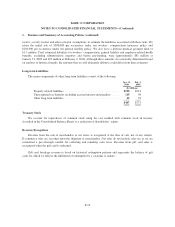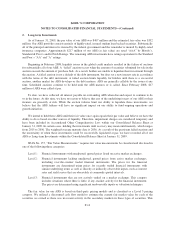Kohl's 2008 Annual Report Download - page 51
Download and view the complete annual report
Please find page 51 of the 2008 Kohl's annual report below. You can navigate through the pages in the report by either clicking on the pages listed below, or by using the keyword search tool below to find specific information within the annual report.
KOHL’S CORPORATION
NOTES TO CONSOLIDATED FINANCIAL STATEMENTS—(Continued)
1. Business and Summary of Accounting Policies (continued)
Preopening Costs
Preopening expenses relate to the costs associated with new store openings, including advertising, hiring
and training costs for new employees, processing and transporting initial merchandise and rent expense.
Preopening costs are expensed as incurred.
Income Taxes
Income taxes are accounted for under the asset and liability method. Under this method, deferred tax assets
and liabilities are recorded based on differences between the amounts of assets and liabilities recognized for
financial reporting purposes and such amounts recognized for income tax purposes. Deferred tax assets and
liabilities are calculated using the enacted tax rates and laws that are expected to be in effect when the differences
are expected to reverse. We establish valuation allowances for tax benefits when we believe it is more likely than
not that the related expense will be deductible for tax purposes.
On February 4, 2007, we adopted Financial Accounting Standards Board (“FASB”) Interpretation No. 48,
“Accounting for Uncertainty in Income Taxes—an interpretation of FASB Statement No. 109” (“FIN 48”),
which clarifies the accounting and disclosure for uncertainty in tax positions, as defined. FIN 48 seeks to reduce
the diversity in practice associated with certain aspects of the recognition and measurement related to accounting
for income taxes. Our liability for unrecognized tax benefits was not impacted by the implementation of FIN 48.
We recognize interest and penalty expense related to unrecognized tax benefits in our provision for income
tax expense.
Net Income Per Share
Basic net income per share is net income divided by the average number of common shares outstanding
during the period. Diluted net income per share includes incremental shares assumed to be issued upon exercise
of stock options.
The information required to compute basic and diluted net income per share is as follows:
2008 2007 2006
(In Millions except per share data)
Numerator—net income ....................................... $ 885 $1,084 $1,109
Denominator—weighted average shares
Basic .................................................. 306 318 332
Impact of dilutive employee stock options (a) .................. 123
Diluted ................................................ 307 320 335
Net income per share:
Basic .................................................. $2.89 $ 3.41 $ 3.34
Diluted ................................................ $2.89 $ 3.39 $ 3.31
(a) Excludes 18 million options for 2008, 9 million options for 2007 and 8 million options for 2006 as the
impact of such options was antidilutive.
F-12
























